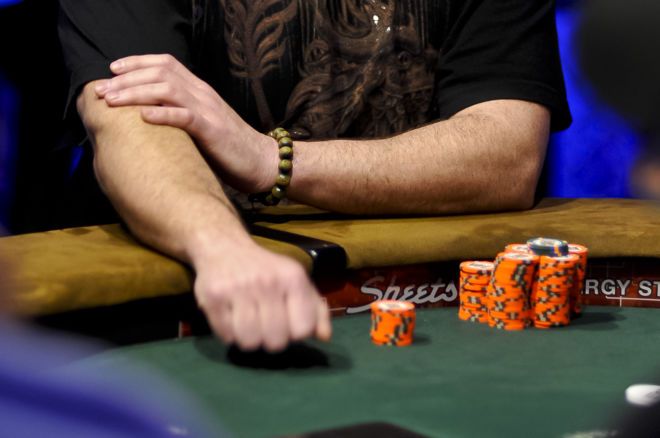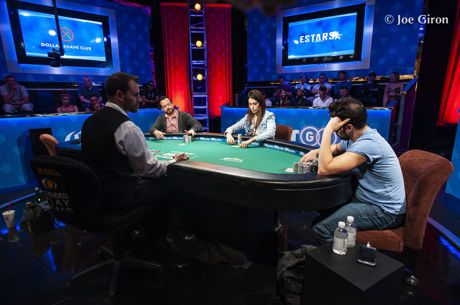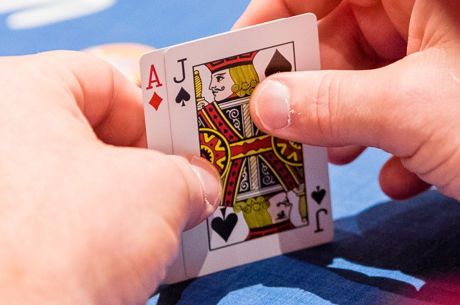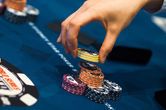The Suspicious Check-Back: When They Don't Bet When They 'Should'

Sometimes we will encounter a situation where a very straightforward poker player does not make what seems to be the straightforward play.
For example, say it's late in a tournament and we're facing off postflop against an opponent with a lot of chips who is in a obvious spot to put pressure on us with a bet. But on a very clear card to bluff, our opponent checks. What can we take from this?
We need to pause and consider our opponent's range of possible hands very carefully in these situations in order to interpret what is going on with a clear head. That is, when something unexpected like this happens, we need to be careful not to let our thoughts about what should be happening cloud our perception of what actually is happening.
Let's look more closely at a hand that demonstrates this particular situation in order to help us the next time we face something similar.
A blind defense, then check-calling the flop
It's a $50 freezeout tournament played online, and we've made it to the final 10 players currently playing at two five-handed tables when we are dealt Q?5? in the big blind.
This is not normally a hand we would be looking to play, but when it is short-handed there are plenty of situations it could happen �� say, when the chip leader comes into the pot from the button for a minimum raise. With 50 big blinds in our stack, calling and seeing a flop is going to serve us much better than folding and letting the rich get richer.
So when the big stack on the button does min-raise we call, and the flop comes 8?4?4? to give us a flush draw and a backdoor straight draw along with an overcard. We check, and our opponent bets 40 percent of the pot.
Raising would certainly be possible here. We have a strong hand that benefits from folds and can improve on plenty of cards to beat other strong hands. But because there is ICM pressure �� we can probably fold all the way to fifth or sixth place as it is �� playing an all-in pot to risk busting 10th is a big disincentive to bloating this pot.
Thus we take our price for the second time in this hand and we call the continuation bet.
The curious case of the checked turn
The turn is an offsuit-king, the K?, a card that should almost never improve the hands with which we called on the flop.
Consider the weakest hands we continue with on the flop. Those might be ace-highs or gutshot draws like 7-6, 7-5, and 6-5. We will sometimes have hands with an eight in them, one of which is K-8, and we will have flush draws as well, a few of which contain a king. In other words, the vast majority of our flop check-calls hate this turn.
Given all that, when we check and our opponent is in a stack-ICM situation in which he can put pressure on us, we should expect him to do so. It would be correct for our opponent to bet with basically any hand with which he bet the flop �� there is simply very little we can do about it if our opponent bluffs this card.
But our opponent checks. Why might the big stack on the button decide to do this?
Well, if this card has so much fold equity for him �� that is, if a bet puts so much pressure on our range of hands �� then a logical conclusion might be that he has a hand that does not want to put too much pressure on us. Or any pressure. What might those hands be?
Only hands that do not require protection of any kind could consider themselves strong enough to encourage our opponent not to put pressure on our range of hands. Even a strong hand like A-A needs to protect against flush and straight draws.
For that reason, we are thinking mostly of full houses and K?X? hands. A hand like 8-8 is more likely to have slow played the flop than this card after having bet the flop. But hands like K-K and K-4 may feel they are simply too strong to bet this card �� they expect to receive too many folds. And K?X?, while only top pair now, has very little to worry about.
Hands like Q-Q down to 9-9 or 8-x might, in a straightforward player's hands, check this card as well.
Solving the case on the river
The river is the A?, making the final board 8?4?4?K?A?. We check our second-nut flush, and our opponent bets 80 percent of the pot.
With those hands we just mentioned �� Q-Q to 9-9 and 8-x �� if our opponent was pot controlling the turn, he could hardly be emboldened to bet this river, a second overcard that completes the most obvious draw. With those hands we would expect him to check back this river card.
On the other hand, if our opponent had a bluffing hand, we should let him bluff this card. But wait �� why didn't he bluff those hands on the turn, which was an even better bluffing card than this?
The point is we should be suspicious here, and from that suspicion conclude we cannot raise this hand for value, though we might in almost any other circumstance. We are either up against a value hand that we cannot beat, an ace that might not call, or a bluff that never will. Meanwhile worse flushes would have bet the turn.
What happened? We called and lost to the king-high flush. But having minimized our loss in the hand, we were still able to reach the final table with a top stack �� all thanks to having correctly been aware of what it meant when our opponent did not bet in a spot where it seemed as though he should.









